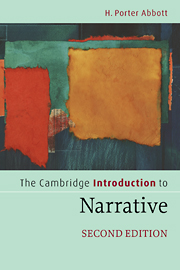Book contents
- Frontmatter
- Contents
- List of illustrations
- Preface
- Preface to the second edition
- Acknowledgments
- Chapter 1 Narrative and life
- Chapter 2 Defining narrative
- Chapter 3 The borders of narrative
- Chapter 4 The rhetoric of narrative
- Chapter 5 Closure
- Chapter 6 Narration
- Chapter 7 Interpreting narrative
- Chapter 8 Three ways to interpret narrative
- Chapter 9 Adaptation across media
- Chapter 10 Character and self in narrative
- Chapter 11 Narrative and truth
- Chapter 12 Narrative worlds
- Chapter 13 Narrative contestation
- Chapter 14 Narrative negotiation
- Notes
- Bibliography
- Glossary and topical index
- Index of authors and narratives
Chapter 12 - Narrative worlds
- Frontmatter
- Contents
- List of illustrations
- Preface
- Preface to the second edition
- Acknowledgments
- Chapter 1 Narrative and life
- Chapter 2 Defining narrative
- Chapter 3 The borders of narrative
- Chapter 4 The rhetoric of narrative
- Chapter 5 Closure
- Chapter 6 Narration
- Chapter 7 Interpreting narrative
- Chapter 8 Three ways to interpret narrative
- Chapter 9 Adaptation across media
- Chapter 10 Character and self in narrative
- Chapter 11 Narrative and truth
- Chapter 12 Narrative worlds
- Chapter 13 Narrative contestation
- Chapter 14 Narrative negotiation
- Notes
- Bibliography
- Glossary and topical index
- Index of authors and narratives
Summary
Narrative space
In Chapter One, I noted that even when you look at pictures you often see narrative. In fact, many pictures cannot be understood without this narrative reflex. Now I want to reverse this insight for one that is equally true: we grasp narrative of any length not only in time but in space as well. The case is easy to make in film and drama. Filmed narrative, after all, is a matter of “moving pictures.” And even plays on a bare stage present us with characters in spatial relations that shift over narrative time. Nonetheless, it was perhaps in part because the plays he watched were performed on a bare stage that Aristotle featured what he called the muthos or, roughly, the course of the action. Since then, most studies of narrative (including this one) have tended to follow Aristotle in his emphasis. Yet, however true it may be that narrative is the representation of events in time, it is no less true that these representations are in space as well.
I'm only speculating, but it could be that the neglect of space in the study of narrative may have come from the fact that narrative scholars, especially in the early years, tended to focus on verbal narrative, oral and written. These are forms where the audience cannot physically see what's happening. Or it may have come from an emphasis on suspense, the engine of narrative.
- Type
- Chapter
- Information
- The Cambridge Introduction to Narrative , pp. 160 - 174Publisher: Cambridge University PressPrint publication year: 2008



